Healthcare SaaS solutions play a pivotal role in the modern healthcare industry. They provide market-ready options enabling healthcare providers to streamline operations, enhance patient care, and secure sensitive medical data while excluding custom solutions. Healthcare software solutions are at the forefront of innovation, leveraging technologies such as artificial intelligence, machine learning, and predictive analytics to drive operational efficiency and improve patient outcomes.
Aloa excels at helping businesses and startups navigate the intricate healthcare software landscape. With expertise in healthcare software development and a commitment to data security, Aloa empowers healthcare providers and companies to harness the potential of electronic medical records, patient monitoring, and big data analytics. Their healthcare software applications are designed to meet the specific needs of the healthcare sector, ensuring HIPAA compliance and safeguarding patient information.
This blog will explore the 7+ Best Healthcare SaaS Solutions for 2024. We will delve into a comprehensive list of top healthcare software solutions, showcasing their software solutions, pricing plans, and security features. Afterward, you will clearly understand the best medical SaaS platforms available in 2024, enabling you to make informed decisions for your healthcare organization's success.
Stay tuned for valuable insights into this dynamic industry transforming healthcare delivery and management. Let's dive in!
8 Best Healthcare SaaS Solutions for 2024
In 2024, the healthcare industry is set to witness a revolution driven by cutting-edge technology. Healthcare SaaS solutions have emerged as indispensable tools for healthcare providers and organizations seeking efficiency, security, and improved patient care. We have curated a list of the eight best SaaS healthcare solutions for 2024.
Let's explore the top healthcare SaaS solutions shaping healthcare's future with their transformative software solutions.
1. Optum360 - Best for Revenue Cycle Management Services
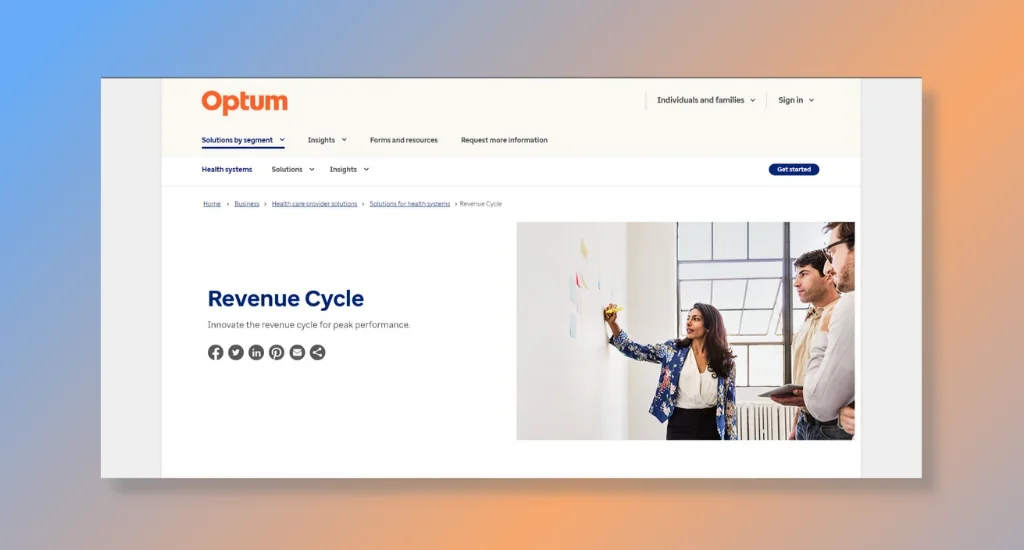
Optum360 excels in advancing the revenue cycle for provider resiliency. They achieve this by aligning payers, providers, and consumers to eliminate unnecessary costs, drive growth, and enhance consumer experiences. Their approach integrates advanced technology, process innovation, clinical intelligence, and analytics to bolster financial performance.
Optum360 has a comprehensive range of revenue performance solutions, including coding and documentation, claims processing, reimbursement, and utilization review. Their utilization of AI-powered technology revolutionizes utilization review, making them unique in the market. Furthermore, they possess an extensive knowledge base for claims editing, ensuring clean claims, a feature not commonly found in other services.
Notable Features of Working with Optum360
- Coding and Documentation: Enhances revenue integrity by unifying clinical and financial domains.
- Claims Management: Utilizes an extensive knowledge base to ensure clean claims.
- Reimbursement Services: Aids in reducing denials and speeding accounts receivable recovery.
- Utilization Review: Employs AI-powered technology to revolutionize this process.
- RCM Outsourcing: Offers solutions to cut costs and increase revenue, improving the bottom line.
Optum360 Pricing Plans
Optum360's pricing information is not readily available online, indicating a customized approach based on each client's specific needs and scale. Interested parties should contact Optum360 directly for tailored pricing plans.
Businesses that benefit most from working with Optum360 are healthcare providers and systems seeking comprehensive, AI-enhanced revenue cycle management services. Optum360's services are ideal for large-scale hospitals and health systems focused on long-term growth and operational efficiency.
2. CareCloud - Best for Modern Medical Practices
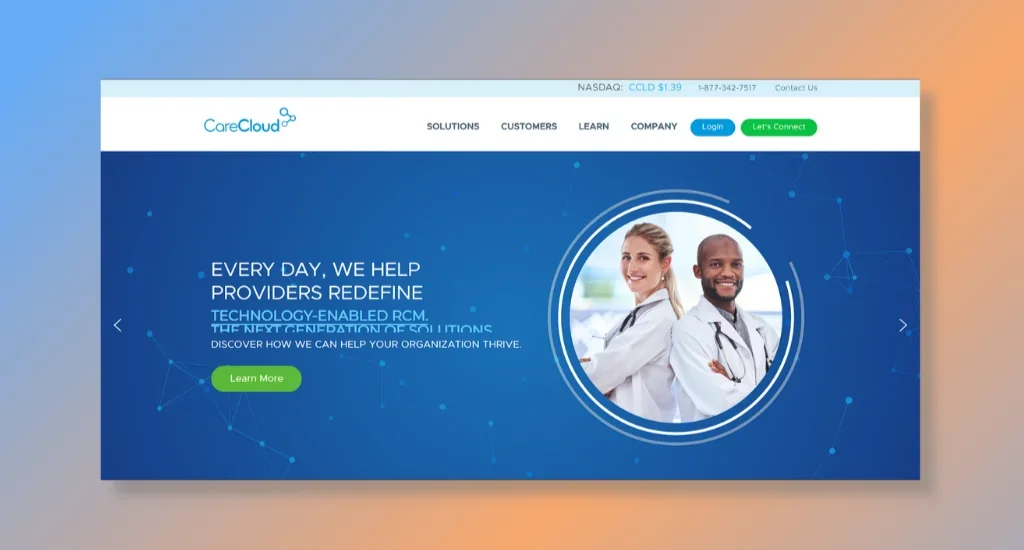
CareCloud is a premier choice for modern medical practices seeking to redefine healthcare solutions with technology-enabled Revenue Cycle Management (RCM). They help healthcare providers maximize practice productivity through RCM optimization, ensuring increased profitability and decreased administrative burdens.
CareClouds' cirrusAI, their digital healthcare assistant, is leveraging generative AI. This technology not only enhances patient care but also streamlines workflows and optimizes revenue, placing CareCloud at the forefront of innovation in healthcare technology. Their comprehensive suite of software and services empowers providers with solutions like Electronic Health Records, Practice Management, Patient Experience Management, Digital Health tools, Telemedicine, and Business Intelligence, each designed to improve clinical, financial, and operational outcomes.
Notable Features of Working with CareCloud
- cirrusAI Integration: A standout feature that leverages AI to enhance patient care and optimize revenue.
- Revenue Cycle Management: Designed to increase profitability and streamline administrative tasks.
- Electronic Health Records: Drive better clinical, financial, and operational outcomes.
- Telemedicine Capabilities: Easy virtual visits to connect with patients wherever they are.
- Business Intelligence: Provides insights for data-driven decision-making.
CareCloud Pricing Plans
CareCloud offers three pricing plans:
- CareCloud Central: Priced at $349 per provider per month.
- CareCloud Complete: Available at $629 per provider per month.
- CareCloud Concierge: A Revenue Cycle Management solution charging 3-7% of practice collections.
Their services are ideal for practices focusing on enhancing patient experiences, optimizing administrative processes, and making data-driven decisions. CareCloud caters to a diverse spectrum of healthcare providers looking for comprehensive, technology-driven solutions by offering various services, from electronic health records to telemedicine.
3. Practice Fusion - Best for Free EHR Solution

Practice Fusion is renowned for empowering medical practices to focus on what matters most – patient care. They streamline charting with a cloud-based Electronic Health Record (EHR) system, offering customizable chart notes, a library of medical charting templates, and unique shortcuts to enhance efficiency. Their platform facilitates seamless prescription management, including handling controlled substances and those requiring prior authorization, across all 50 states.
Practice Fusion's platform stands out because it connects efficiently with over 98,000 pharmacies and more than 500 lab and imaging centers. This integration simplifies the exchange of information and streamlines workflow. Moreover, they offer flexible billing options with industry-leading partners and simplify participation in quality initiatives like MIPS, providing valuable dashboards and expert support.
Notable Features of Working with Practice Fusion
- Streamlined Charting: Offers templates and patient charts in the cloud that are customizable to practice needs.
- Seamless Prescription Management: Manages prescriptions efficiently, including e-prescribing to any pharmacy.
- Efficient Connectivity: Integrates with pharmacies, labs, imaging centers, and other EHR tools.
- Flexible Billing Options: Collaborates with partners for faster payment processing.
- Quality Initiative Support: Provides dashboards and expert quality reporting and managementsupport.
Practice Fusion Pricing Plans
Although known for its free EHR solution, Practice Fusion transitioned to a subscription-based model in 2018. The base plan starts at $149 per provider per month, including three signing staff licenses and unlimited non-signing staff licenses, with implementation, training, and customer support included. They also offer a risk-free 14-day trial with no hidden fees or credit card required.
Practice Fusion is ideally suited for smaller, cost-conscious medical practices looking for a complete EHR system. The platform is particularly beneficial for practices prioritizing streamlined operations, integrated systems, and cost-effective solutions to enhance patient care and practice management.
4. Relatient - Best for Patient Engagement and Communication
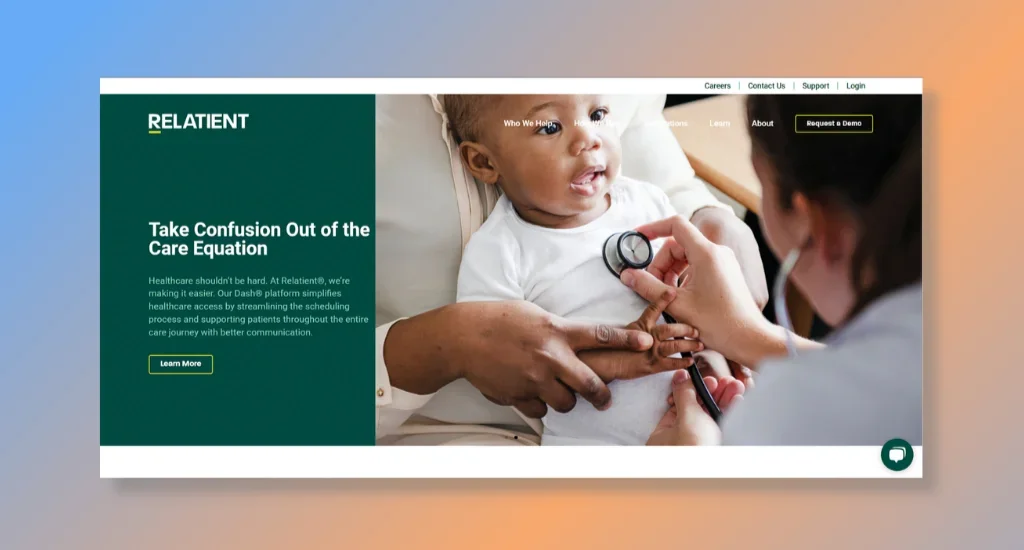
Relatient, with its Dash® platform, excels in patient engagement and communication. This platform combines advanced scheduling and communication tools to enhance patient access and engagement throughout their care continuum. It simplifies healthcare access by streamlining the scheduling process and supports patients throughout their care journey with better communication, thus making healthcare more accessible and manageable for providers and patients.
Relatient's Dash platform stands out by integrating patient self-scheduling, call-center scheduling, modern two-way patient communication tools, and digital registration, providing comprehensive access and improved provider schedule utilization. The platform's seamless messaging and targeted engagement deliver a superior patient experience through personalized and efficient multi-channel communication. Additionally, it simplifies patient intake and check-in paperwork, reducing registration headaches for patients and providers.
Notable Features of Working with Relatient
- Streamlined Patient Scheduling: Offers a guided user experience for provider staff and patients, optimizing capacity and access.
- Automated Appointment Reminders: Reduces patient no-shows and increases healthcare efficiency and effectiveness.
- Two-Way Communication: Enables efficient patient-staff interaction, increasing staff productivity and patient satisfaction.
- Digital Billing Solutions: Speeds up the collection of patient payments, reducing bad debt and write-offs.
- Virtual Waiting Rooms: Facilitates a safer and more streamlined check-in process, essential for telehealth and in-person visits.
Relatient Pricing Plans
Relatient starts at $99, making it a cost-effective option, especially suitable for larger-sized corporations. It can be deployed in the cloud and on-premise and is accessible from a limited number of platforms, including Windows devices.
Relatient is particularly beneficial for healthcare providers looking to enhance patient engagement and streamline communication processes. The platform's ability to connect efficiently and its targeted engagement features make it a valuable asset for any healthcare organization focusing on improving patient satisfaction and operational efficiency.
5. eMDs - Best for Comprehensive Health Records
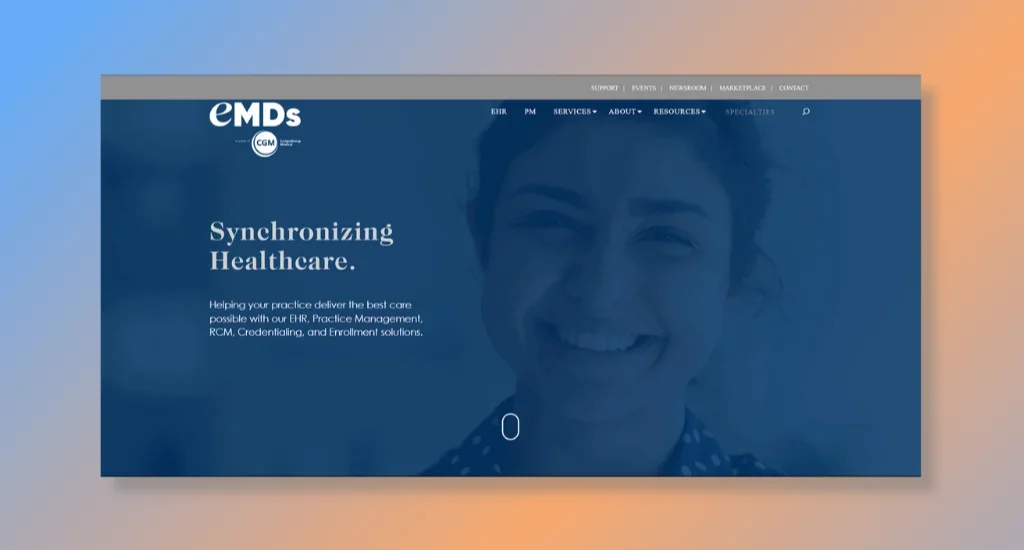
eMDs, a brand of CompuGroup Medical, offers an electronic health record (EHR) and practice management software designed for the dynamic needs of busy practices. With over 23 years of experience working with various-sized practices, eMDs understand the real-world system requirements to support patient care efficiently. Their software is developed with input from practicing clinicians and billers, ensuring that it meets the practical needs of medical professionals.
eMDs services are tailored to improve the financial performance of healthcare practices. They reduce the regulatory, technological, and administrative burdens, allowing providers to focus more on patient health. Their revenue cycle, credentialing, and enrollment expertise craft solutions that fit unique practice needs. This holistic approach is crucial for seeking a comprehensive system encompassing all aspects of healthcare management.
Notable Features of Working with eMDs
- Efficient Access to Patient Records: eMDs' EHR ensures quick access to patient records, simplifies scheduling, and streamlines the billing process.
- Voice Recognition for Easy Dictation: The EHR features strong dictation capabilities, enabling clinicians to compile notes more quickly and accurately than manual methods.
- Adaptive Learning for Data Entry: The system uses adaptive learning to capture and anticipate likely next steps in patient care, enhancing efficiency in diagnosis and medication suggestions.
- Interoperability: eMDs' EHR supports interoperability, allowing seamless data exchange with various medical entities like labs, clinics, and hospitals.
- Mobile Accessibility: The EHR is mobile-friendly, with apps for tablets and smartphones.
eMDs Pricing Plans
eMDs offers services starting from $399 per month on a subscription basis. This pricing is considered reasonable and fits any business of any size. The platform is deployable in the cloud and on-premise, accessible from a limited number of platforms, including Windows and Linux devices.
eMDs are particularly beneficial for healthcare providers seeking a comprehensive EHR system that addresses all facets of patient care and practice management. The platform's adaptability to different practice sizes and its interoperability with various healthcare entities further solidify its suitability for a broad range of medical practices.
6. Suki.AI - Best for AI-Powered Clinical Documentation
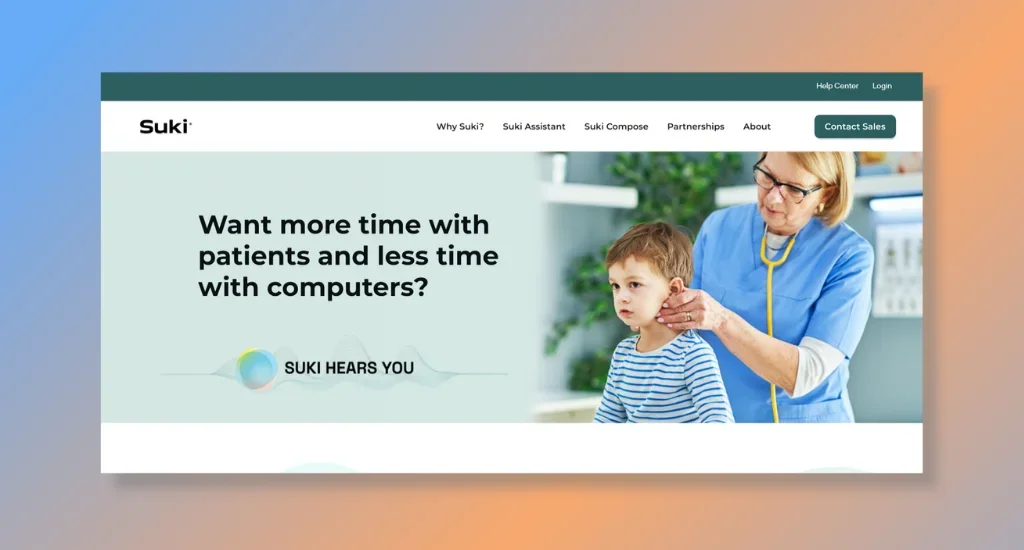
Suki.AI stands out as a pioneering AI-powered voice assistant built explicitly for healthcare. It aids clinicians by generating notes ambiently, taking dictation and commands, simplifying coding, and answering questions, all integrated deeply with electronic health records (EHRs). This advanced technology significantly reduces the time required for everyday clinical tasks, enhancing the clinician experience.
Suki.AI allows clinicians to create notes in ambient, dictation, or command modes within a single application. This flexibility, combined with enterprise-grade bidirectional EHR integrations, ensures content syncing between Suki and the EHR for up-to-date information in notes. Clinicians can start notes in the EHR and finish in Suki or vice versa, providing ultimate flexibility in documentation.
Notable Features of Working with Suki.AI
- Advanced AI Technologies: Suki.AI employs medically tuned automatic speech recognition (ASR) and natural language understanding (NLU).
- Adaptive Learning: You can apply its language model to data from over 1 million patient records across 35+ specialties.
- EHR Integration and Workflow Support: Suki.AI syncs clinical notes to appropriate sections in the EHR, pulls relevant patient information in real-time, supports flexible workflows, and streamlines the documentation process.
- Security and Compliance: The platform has received certifications for SOC2 Type 1 and 2.
- Broad Application: Suki.AI can be used for diagnosis coding, real-time information retrieval, and completing various administrative tasks.
Suki.AI Pricing Plans
- Suki Assistant: Priced at $399 per user per month, offering clinical assistance with deep EHR integrations.
- Suki Compose: This enterprise-grade clinical documentation app is available at $299 per user per month.
Suki.AI is particularly beneficial for healthcare providers seeking to enhance clinical documentation efficiency and reduce administrative burdens. The platform's adaptability to various clinical settings and its ability to ensure rapid innovation in healthcare technology further establish its role as a leader in AI-powered clinical documentation.
7. RXNT - Best for E-Prescribing and Medical Billing
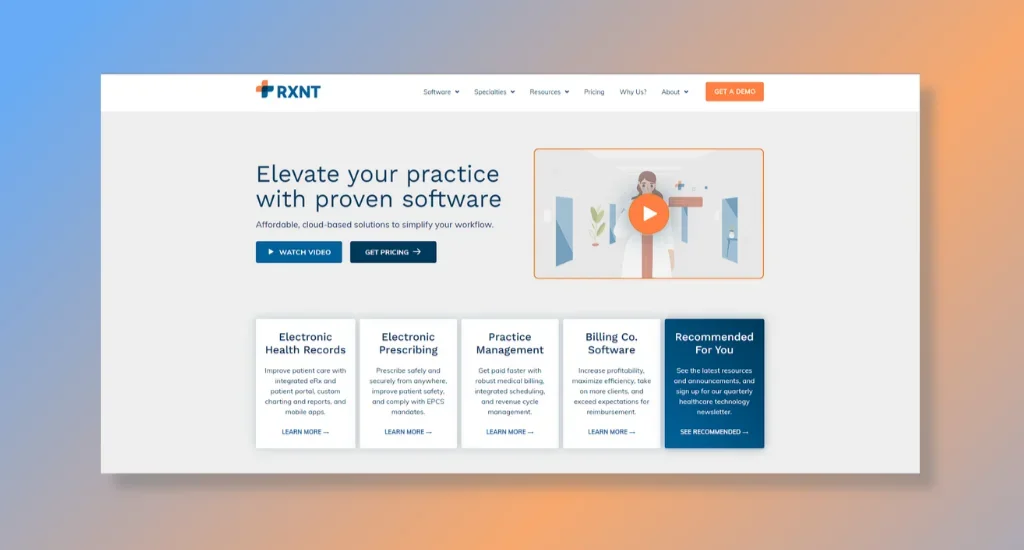
RXNT stands as a pivotal solution in the realm of e-prescribing and medical billing. It offers an integrated Electronic Health Records system that enhances patient care with features like integrated e-prescribing, patient portal, custom charting and reports, and mobile apps. RXNT’s e-prescribing software ensures safe and secure prescription management from any location, complying with Electronic Prescribing for Controlled Substances (EPCS) mandates.
RXNT excels in electronic prescribing, allowing physicians to send prescriptions digitally from almost any internet-enabled device. This cloud-based system facilitates accessible communication with pharmacies and the handling of refill requests. Its e-prescribing software is integrated with patient medication records and databases, aiding in identifying cost-effective options for patients. Additionally, it includes safety features like automated drug interaction checks and supports Electronic Prior Authorizations (EPAs), streamlining the prescribing process.
Notable Features of Working with RXNT
- Integrated Records and Databases: The e-prescribing software offers integrated patient medication records for optimal prescription management.
- Patient Safety Features: Automated drug interaction checks and EPCS-certified software enhance patient safety.
- Streamlined Prescribing Processes: Supports EPAs and communicates with all U.S. retail and mail pharmacies.
- Medical Billing Efficiency: The medical billing software streamlines the billing process.
- Comprehensive Medical Billing Solution: They ensure HIPAA compliance with secure patient portals, mobile charge capture, and customizable reporting.
RXNT Pricing Plans
RXNT's pricing information is not explicitly detailed on its website. For specific pricing plans, interested parties are encouraged to contact RXNT directly. They offer tailored solutions to fit the unique needs of various practices, ranging from solo practitioners to large multi-specialty groups.
RXNT is particularly beneficial for healthcare practices focused on e-prescribing and medical billing. RXNT's focus on patient safety, efficiency, and compliance positions it as a leading solution for practices seeking to improve their operational workflow while maintaining a high standard of patient care.
8. CarePaths - Best for Telehealth and EHR Integration
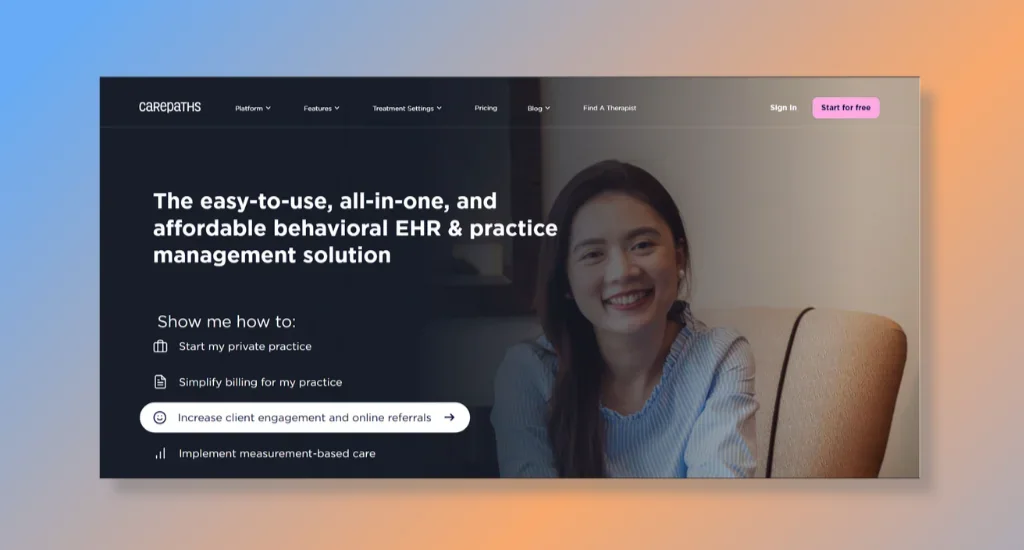
CarePaths specializes in delivering robust solutions for telehealth and Electronic Health Records (EHR) integration. Their offerings primarily target mental health professionals, providing a comprehensive suite of tools essential for efficient practice management. This includes clinical documentation, treatment plans, teletherapy with group support, electronic billing, and automated measurement-based care. Additionally, they offer unique elements such as medication adherence tracking and a digital front door for online referrals, enhancing therapist efficiency and patient engagement.
CarePaths is committed to customizing solutions to fit the specific needs of their users. They go beyond standard offerings by providing customized documents, ensuring that if a required document is not available, their team will create it. This level of personalization, coupled with a user-friendly platform, positions them as a distinct choice in the market.
Notable Features of Working with CarePaths
- Custom Documents: CarePaths offers unique document customization services. If a required form is unavailable, they create it.
- Digital Front Door: It allows patients to self-refer and book appointments online, enhancing accessibility and convenience.
- Teletherapy Platform: Their platform supports group sessions with up to six people, ensuring that practices can maximize accessibility by offering virtual consultations.
- E-Prescribing: CarePaths provides an ONC-certified ePrescribing service, streamlining the prescription process and enhancing the efficiency of medication management.
- Patient Notifications: The system includes automated patient notifications for appointments, missing documents, or assessments, aiding in effective communication and management.
CarePaths Pricing Plans
CarePaths offers diverse pricing plans to accommodate various needs. They provide a free option for up to 30 clients per clinician, with a $9 monthly fee for unlimited measurement-based care. The charge is $49 per month for complete EHR and Measurement-Based Care. Additionally, they offer special pricing for non-profits and educational institutions.
CarePaths is ideally suited for private practices, non-profit organizations, and educational institutions involved in mental health care. Their services benefit those seeking a customizable, comprehensive EHR and telehealth solution, especially appealing to practices that enhance patient engagement and streamline administrative tasks.
Essential Features of Healthcare SaaS Solutions
In healthcare technology, SaaS solutions have emerged as indispensable tools for medical professionals and healthcare businesses. These software-as-a-service applications offer a wide range of features that streamline operations, enhance patient care, and improve overall efficiency.
Let's delve into the essential features of healthcare SaaS solutions.
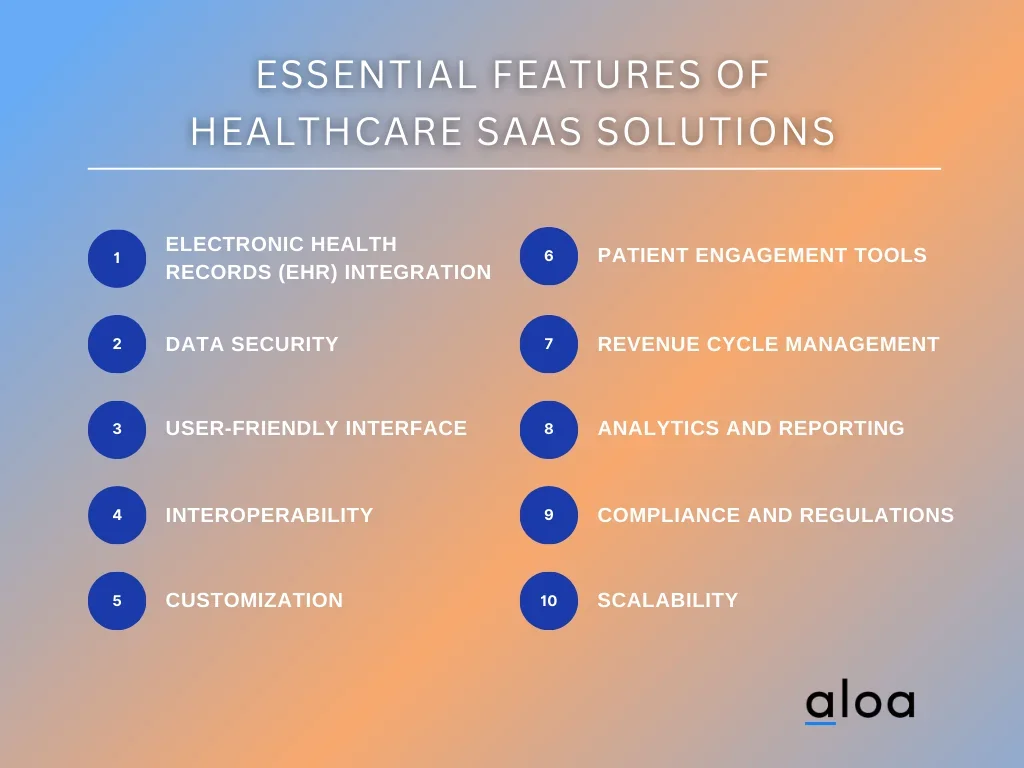
- Electronic Health Records (EHR) Integration: Healthcare software solutions should seamlessly integrate with electronic health record systems. This ensures patient data can be accessed and updated quickly, leading to more efficient care delivery.
- Data Security: Given the sensitivity of patient information, robust data security measures are paramount. Healthcare SaaS solutions must comply with industry standards to protect patient data from breaches and unauthorized access.
- User-Friendly Interface: Medical professionals often have demanding schedules. Therefore, an intuitive and user-friendly interface is essential for quick adoption and ease of use.
- Interoperability: The ability to connect with other healthcare systems and share data is crucial. Interoperable Healthcare SaaS solutions facilitate collaboration among various healthcare professionals and institutions.
- Customization: Healthcare businesses have diverse needs. Customization options allow SaaS solutions to be tailored to the specific requirements of healthcare companies and individual practices.
- Patient Engagement Tools: Effective patient engagement is crucial for improving healthcare outcomes. Features like appointment scheduling, telehealth capabilities, and patient portals enhance the patient experience.
- Revenue Cycle Management: Managing financial aspects of healthcare operations is simplified with revenue cycle management features. These tools help healthcare businesses optimize billing, claims processing, and reimbursement.
- Analytics and Reporting: Healthcare SaaS solutions should offer robust analytics and reporting features. These tools allow healthcare professionals to gain insights from data, track key performance indicators, and make informed decisions.
- Compliance and Regulations: Staying compliant with healthcare regulations is non-negotiable. SaaS solutions should assist healthcare businesses in adhering to regulations like HIPAA (Health Insurance Portability and Accountability Act). This includes ensuring HIPAA-compliant administrative support for virtual assistants, third-party billing services, and safeguarding patient information when integrating external services.
- Scalability: As healthcare businesses grow, their software needs to grow. Scalability ensures that the SaaS solution can accommodate increased patient loads and expanded services.
How to Choose The Best HealthCare SaaS Solution
Choosing the proper healthcare SaaS solution is crucial for medical institutions, business owners, and medical staff. Adopting Healthcare software solutions has become a significant trend, revolutionizing how healthcare services are delivered and managed.
To help you navigate this dynamic landscape, here are five key factors to consider when selecting the best healthcare SaaS solutions.
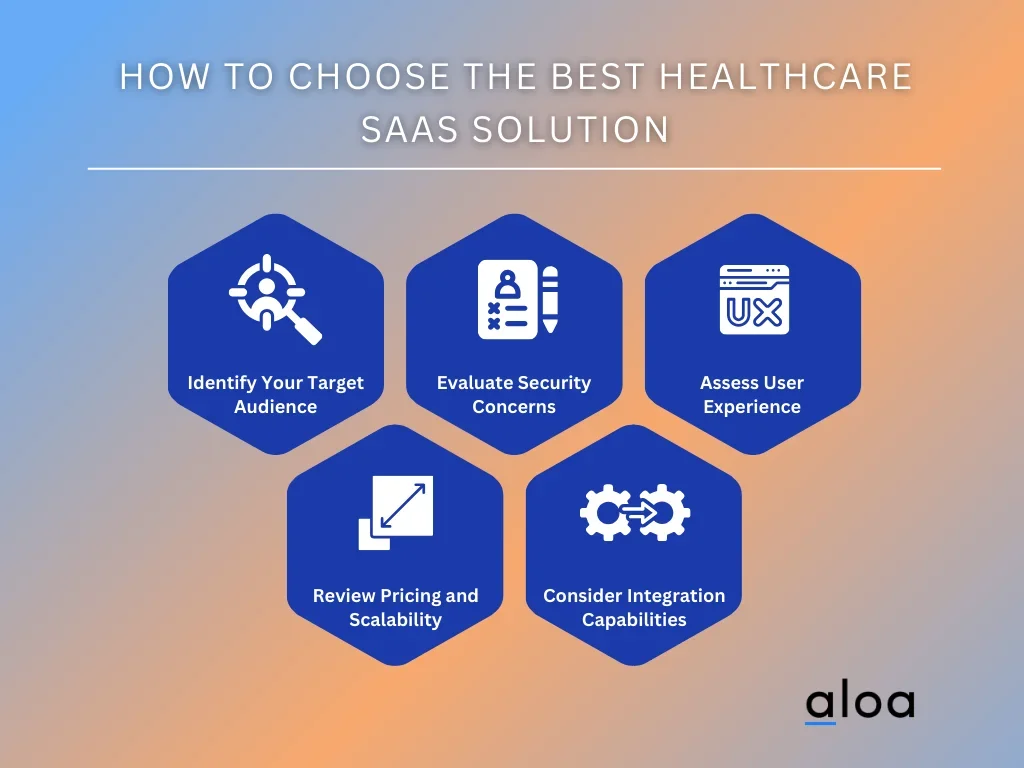
Identify Your Target Audience
Before diving into the multitude of healthcare SaaS companies, it's essential to pinpoint your target audience and their specific needs. Different Healthcare software solutions cater to various verticals within the industry, such as practice management, supply chain, or information systems. Understanding your audience and their requirements will help you narrow the options and focus on solutions tailored to your niche.
Evaluate Security Concerns
Healthcare data security is crucial, and any healthcare SaaS solution you choose must comply with industry standards and regulations. Look for SaaS vendors prioritizing data encryption, user authentication, and access control. Address potential threats and vulnerabilities to ensure the safety of sensitive health information.
Assess User Experience
The best part of adopting healthcare software solutions is their potential to enhance user experience. Evaluate the user-friendliness of the SaaS app, as a well-designed interface can significantly impact efficiency and productivity. Test the software's user interface and seek feedback from your medical staff to ensure a seamless experience.
Consider Integration Capabilities
Healthcare institutions often rely on various systems and applications to manage their operations. Choose a healthcare SaaS solution that seamlessly integrates with existing software and tools. This ensures a smooth transition and avoids disruptions in your workflow.
Review Pricing and Scalability
While cost is a critical factor, it should be weighed against the scalability of the healthcare SaaS solution. Look for flexible pricing plans that align with your budget and consider the long-term costs associated with the software. Ensure that the SaaS product offers room for growth and can adapt to the evolving needs of your healthcare business.
Key Takeaway
Healthcare SaaS solutions play a pivotal role in the healthcare industry, offering innovative ways to streamline operations and enhance patient care. As healthcare business owners seek to stay ahead of SaaS trends, they must evaluate their options carefully when considering Healthcare software solutions. These solutions provide scalability, data security, and interoperability benefits in vertical or horizontal SaaS models.
By leveraging natural language processing and cloud solutions, healthcare applications are becoming more powerful, providing actionable insights and improved customer service. To keep up with the global healthcare cloud trend, businesses should focus on finding Healthcare software solutions that align with their specific needs and goals.
The next step toward efficiency and growth is choosing the right healthcare SaaS solution. For more information, contact us at [email protected] and explore the possibilities that Healthcare software solutions can offer in the ever-evolving healthcare landscape.

